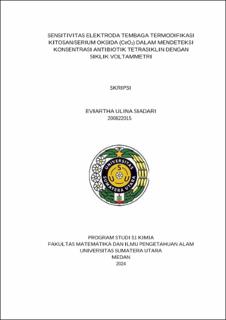Sensitivitas Elektroda Tembaga Termodifikasi Kitosan/Serium Oksida (CeO2) dalam Mendeteksi Konsentrasi Antibiotik Tetrasiklin dengan Siklik Voltammetri
Sensitivity of Chitosan/Cerium Oxide (CeO2) Modified Copper Electrode in Detecting Concentrations of Tetracycline Antibiotics with Cyclic Voltammetry

Date
2024Author
Siadari, Eviartha Ulina
Advisor(s)
Nainggolan, Irwana
Metadata
Show full item recordAbstract
Chitosan/Cerium Oxide (CeO2) modified copper electrode with a simple and
sensitive has been successfully carried out using a cyclic voltammetric method to
detect tetracycline antibiotic. The effect of the addition of cerium oxide on the chitosan
has been shown to improve the sensing properties of the chitosan electrodes.
Chitosan/CeO2 was fabricated using the electrodeposition method at a volume ratio
of 1:1 in the form of a 1.5% chitosan solution and various CeO2 concentrations of
0.005, 0.0075, 0.001, 0.0125 and 0.015g. The sensing properties of the chitosan/CeO2
electrode were tested against tetracycline antibiotics with concentrations of 0.1, 0.5,
1, 1.5 and 2 ppm. The characteristics of the chitosan/CeO2 electrode were analyzed
using the Scanning Electron Microscopy (SEM) and Fourier Transform Infra-Red
(FT-IR) methods. The measurement parameters in this study are low E(V) = -1, high
E(V) = +1, scan rate (mV/second) = 75, these parameters are used until the end of the
test for analyzing tetracycline antibiotics using the cyclic voltammetry method. The
results of the test produce the maximum output voltage of 0.0075g chitosan/CeO2 at a
potential of 0.00328 V, a high performance chitosan/CeO2 based electrode used to
detect variations in the concentration of tetracycline antibiotics. A tetracycline
antibiotic concentration of 0.0075g produces the highest peak oxidation current and
potential namely 7.05392 A and 0.992 V. The detection limit (LOD) and quantity limit
(LOQ) for detecting tetracycline antibiotics are 0,5533 μM dan 1,8447 μM. The results
of this research show that the modified chitosan/CeO2 electrode is able to detect
tetracycline antibiotics with the lowest levels and good sensitivity so that it can be
applied as a basic sensor material for detecting tetracycline antibiotics
Collections
- Undergraduate Theses [1411]
